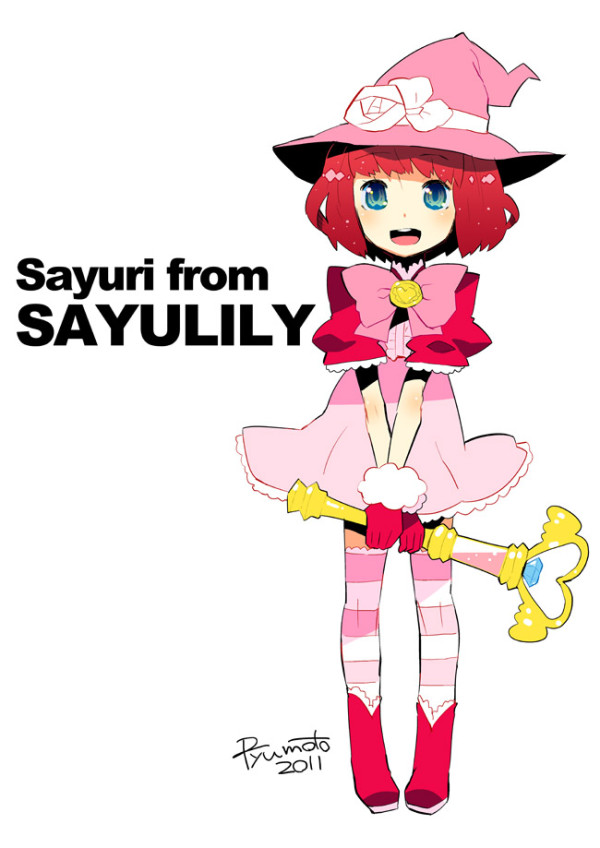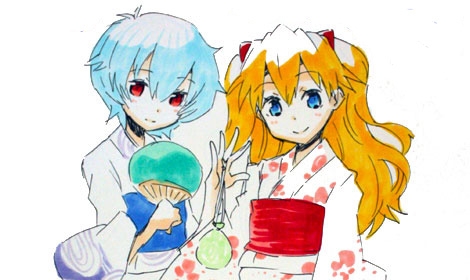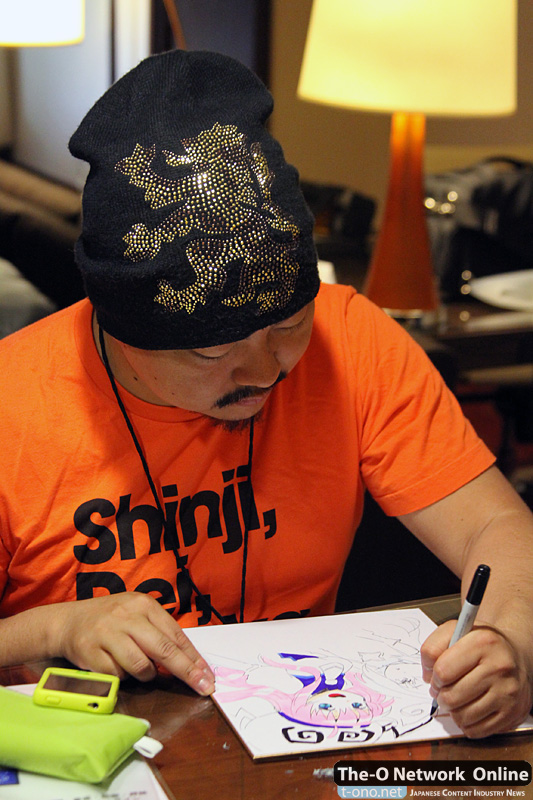Ryusuke Hamamoto is a Japanese artist who is probably best known for his character design work on the Petit Eva: Evangelion@School series. Hamamoto-san has also adapted characters from popular anime series (To Love-Ru, K-ON!, Macross Frontier, etc.) for Bandai's figurine line, R-style named after himself.
In one of our most extensive interview, we discuss with Hamamoto-san at Kintoki-Con in Sacramento, some of the various aspects involved in designing characters, how he developed his own unique style, and his inspirations and American influences.
T-ONO: You were at FanimeCon in San Jose a couple of weeks ago, and now you are here in Sacramento at Kintoki-Con. Have you enjoyed your visit so far in the United States or seen anything interesting?
Ryusuke: Other than FanimeCon and Sacramento, I've been to the aquarium in Monterey. And with the help of the FanimeCon staff, I was able to check out an elementary school in San Jose and take some pictures of the classrooms for use in my later creations, so it was a really nice view spot. I walked around and took pictures of houses in the United States to use as a reference. It's been really fun and interesting going around Sacramento and everywhere else.
T-ONO: We know you're currently working on a new project, so is some of these pictures that you've taken going to be used in your new project?
Ryusuke: In my future creation, I was going to write about something that takes place in the United States, so I was actually getting more out of it than I was expecting from it, so it's really nice to be here.
T-ONO: Since you've been here, have you been meeting your fans? What's your reaction to them?
Ryusuke: Simply, I actually had a lot of fun seeing my fans in the United States because having fans overseas is a big step for me. I like Hellboy and American comics since I was a professional artist in the manga industry, so I wanted to have fans and to be able to work overseas, which is why I kept doing Deviantart, blog posts, and tutorial videos. In the future, I want to be able to go overseas and work in the United States, so being invited here made me very excited and happy to be able to interact with my fans who love my work.
T-ONO: How did you get into your professional career?
Ryusuke: I actually really wanted to be a manga artist since elementary school and I kept on thinking that I wanted to be a manga artist in the future, so that's how I wanted to be in this industry. During high school, I really wanted to become a manga artist, so I sent my manga twice to publishers. I didn't get any awards for the manga I sent in during high school, but after I graduated I went to college in Tokyo.
When I went to college, I kept sending in more of my work to publishers. For about two years in college, I kept doing this, but I never got any awards or into any publishers. One day, the publisher told me that I'm really good at drawing pictures and suggested why don't I send my work to illustration publishers instead of manga publishers. So that's what I did. I kept sending my illustrations, but I still couldn't get into any publishers.
I wanted people to see my creations, so I started drawing doujinshi and sold them at Comiket [one of the largest anime and manga themed fan works convention in Japan]. While I was doing that, a publisher wanted someone who could draw girls and cute pictures. A publisher found my work and recommended me to draw something for the publisher. This is how I became a professional artist and started to draw professionally, by being scouted at Comiket. I was about to graduate from college when it happened, so it took me another two years to get to that spot.
T-ONO: Approximately what year did you get into drawing professionally?
Ryusuke: I was doing illustrations for some places, but I became a professional manga artist like in 2004.
T-ONO: How much material did you send during your high school and college years to publishers? Were they the same materials?
Ryusuke: I actually like comedy manga, so I kept drawing comedy manga. Every time I sent in my work, I changed the story, but the genre was always comedy.
T-ONO: Are there any particular works or projects that you'd like to be a part of?
Ryusuke: Instead of having a manga drawn in Japan and translated, I'd like to draw an original manga for the U.S. viewers that originated in the U.S. without having it translated. I would like to do that because there are a lot of cultural differences. When you write a manga for Japanese people there's cultural reference for the Japanese audience. What I want to do is draw American manga with American culture references so American people could see, read, and understand much better. That's what I want to do.
Also, I don't know if I'll do it or not, but I want to work as a character designer for an anime for American viewers, not Japanese translated anime, but American productions. I'd like to do American cartoons in the future.
T-ONO: So something like Heroman (ヒーローマン), are you familiar with that series?
Ryusuke: I'm actually friends with the character designer of Heroman, Koyama Shigeto, and I actually saw him work with the American staff producing the series, so I got a little jealous as I wanted to be a part of an American production.
T-ONO: We hope that one day you can be a part of something like that.
Ryusuke: I hope so too! [laugh]
T-ONO: Your panel yesterday was very informative and very instructional; it was almost like an art lecture. Have you given any other type of lectures or something along those lines?
Ryusuke: Actually, this year I was teaching how to draw at an art institute in Japan.
T-ONO: What was it like?
Ryusuke: It was my first time to teach someone how to draw something, so it was a really interesting experience because I'm not at that level yet. The knowledge that I knew was really hard, but it was really interesting to teach those kids, or students on how to draw based only on my knowledge. I also have a limited knowledge on the subject, but it was a really good experience and taught me a lot by teaching those students how to draw.
Whenever I went to the art institute to teach, I thought the students would be expecting me to be like, "oh a professional artist illustrator is coming in to teach me!" So I was thinking that I really needed to act more professional and I don't show any weak spots in any way. I had that kind of mindset when I was doing the panel. So it might have sounded like I was giving a lecture rather than a panel, maybe that's why it was like a little class in a way.
T-ONO: I actually do a little bit of artwork on the computer, and to me, I found your panel to be very helpful.
Ryusuke: It's really a pleasure that you thought that way because I think it's much more important for a Japanese artist to teach Japanese students, but Japanese or manga artists telling American fans can be difficult because of cultural differences. If you got the idea that the panel was instructional then that's really nice and I'm really thankful for that.
T-ONO: We know that in recent years, especially in anime, a lot of character designs have the same facial structures and hairstyles and it's almost like mix and match. How do you take that approach and keep your characters fresh and original?
Ryusuke: I actually design first by interpreting the trend for that year and at the same time I put my own style into it. If someone sees that picture, they'll know it's my picture.
For something different, I would try to adopt another trend that no one else has used to show originality and to show that this is my picture in this anime and manga industry. Now, because a lot of people try to adapt to the trends, a lot of anime and manga look alike now. For me, I like to try, interpret, and adopt some trends that existed in the Eighties and show how it looks in a drawing today.
I also like to bring in American comic trends like distinctive contrasts between the colors, so I won't use a lot of tones, I'll use contrasts to show my distinctive qualities in these pictures.
T-ONO: When you started, were there any particular inspirations for your art style?
Ryusuke: The most recent influence that helped me draw this style was the comic, Clamp. I have an older sister who usually buys shoujo manga, which had a manga from Clamp. I read the manga and got inspired by the drawing style. An inspiration that I got from American comics was Mike Mignola. Other inspirations I got from American cartoons include Sponge Bob Square Pants, Powerpuff Girls, and Foster's Home. I got a lot of influence from these.
When Japanese mangaka writes cute girls, they'll have nice, cute lines, but in American comics, they'll have distinctive silhouettes or shapes to show their personalities or abilities. I would show my individuality in my pictures and distinguish from other writers by including these lines and silhouettes to show their personalities.
There's a comic writer who wrote Scott Pilgrim, he actually grew up reading Japanese comics and had that kind of drawing style, which I'm influenced by. I hope someone could be influenced in Japan or other countries through my pictures and try to give someone some inspiration that they can adapt into their drawings.
T-ONO: Looking at some of your artwork, I've noticed that there are little diamond shaped highlights on the hair. Are there other distinct styles in your art? Do you plan to change your art style in the next few years?
Ryusuke: When I started with the Petit Eva series, I had really round highlights that I tried to distinguish from other drawings. After two years when I was doing it, other mangaka or fan artists started drawing round highlights too. I got a little bit bored because everybody was doing it, it was no longer my style anymore. So now, I have another distinctive style of highlights like the diamond shape and I'll probably change it if people start catching up again.
Also, I'm going to change my drawing style in the future. I want to try to add more of the American comic style into my pictures to the point where Japanese audience can watch it pleasantly. American people know anime just like Japanese people know American cartoons. I think adding a bit of these distinctive qualities of the American comic into my drawing would be acceptable to the Japanese audience compared to before, which is why I would want to start adapting these American comic styles.
T-ONO: We know you mentioned brush strokes, which is unique. In American comics, most of them are fully colored with very detailed facial structures to fine details, but anime is more abstract. Are there any other specific American comic style that you would like to incorporate into your art besides the ones mentioned before?
 Ryusuke: American comics have dynamics in them, in a way whereas Japanese manga like to exaggerate a few points. In fighting mangas, they will exaggerate one panel to show the dynamics and greatness of the fight or simply the expression. Whereas, American comics will show delicateness, more insight, and more realism. I would love to incorporate those kinds of styles in the future.
Ryusuke: American comics have dynamics in them, in a way whereas Japanese manga like to exaggerate a few points. In fighting mangas, they will exaggerate one panel to show the dynamics and greatness of the fight or simply the expression. Whereas, American comics will show delicateness, more insight, and more realism. I would love to incorporate those kinds of styles in the future.
I've been working on this manga called Usagi Rurikarakusa (ウサギルリカラクサ) since January 2010 and it was my first time drawing a manga that was not a comedy; instead, it had a much more serious tone, which I can't over exaggerate the emotions. If they were angry, I can't just have a little comic, I can't do that anymore. I would need to have a much more serious tone in mind like the emotions on their face. Drawing serious emotions was pretty hard, but at the same time really interesting.
When I was working on Usagi Rurikarakusa, I was reading a comic called Watchmen. In Watchmen, there is this dramatic emotion beneath the art while having a delicate facial expression. I actually got a lot of influence from the comic Watchmen as well, I tried very hard to create those expressions: not dramatic exaggeration, but delicate. It was really interesting for me.
T-ONO: We can say that the exaggeration in American comics tends to, apart from just telling a story through text, tell a story through the emotion and details in the art. Is that what you're trying to bring into your own work?
Ryusuke: Talking about it is so much simpler, but to actually bring those emotions and details into my art is actually quite difficult. To tell a story in a dramatic way, I would need to interpret that into a comic format so I won't need to tell the whole story all the time, but enough for people to use their imagination and try to make them understand through that. My manga is always about these cute girls in comedies, so that's why I was a little bit worried about producing an actual serious comic that the fan might not like, but the fans considered my worries and accepted it. In the future I would like to start producing these kind of comics with serious touches to it.
T-ONO: Out of all of your characters in your projects, which one has been the most fun to work on?
Ryusuke: Actually there was this character from Petite Eva, the first shogoki (Eva 01). I deformed and made Eva 01 into a petite file and called it Evancho (エ ヴァンチョー). Evancho is pretty much one of my favorite characters. I had fun working on Evancho because it was my first time trying to interpret American style comic writing into my own characters. I was a bit afraid that Gainax or someone else would be mad about designing this character since it was my first time interpreting American style comic writing, but it worked out and everybody loved the actual character when it came out in the DVD animation. Evancho was also chosen to be a little character figurine that came with the DVD, which made me very happy.
T-ONO: Can you tell us a little bit about your mascot Hamamoto-tan?
Ryusuke: This character came out of complete coincidence. I needed to create a manga for a magazine that had a lot of cute characters, especially girls, and I was drawing a comedy manga with weird mascots. One day, the publisher got angry because there was not any cute girls in it. I got really angry and created a character with all the aspects of a cute girl for the magazine such as having yellow hair, underwear showing, and twin tails. I also wanted to be an asshole, so I called her my name, Hamamoto-tan... and everybody ended up loving it.
The character was for an actual manga that was in black and white, but when Hamamoto-tan came out, it was full colored. It was really a joke calling her Hamamoto-tan, but then everybody gradually started liking it and I couldn't take it back. So that's how Hamamoto-tan became official.
I'm over thirty years of age, but it feels a little bit weird claiming a girl is fourteen and calling her my name, Hamamoto-tan.
T-ONO: Can you tell us about the newest project that you're working on, and do you have any messages for all your fans over here and inspiration for artists looking to draw in the anime style?
 Ryusuke: My newest creation is a manga coming out called Sayulily (サユリリ). Sayulily has a comedy touch to it, but I'm trying to incorporate different styles into my drawing so that American people can read the manga.
Ryusuke: My newest creation is a manga coming out called Sayulily (サユリリ). Sayulily has a comedy touch to it, but I'm trying to incorporate different styles into my drawing so that American people can read the manga.
I hope you guys enjoyed my interpretation and how I really like manga. And as for the fans in America, I know that fans have to look for my work in Japan, translate it into English, and read it, but hopefully, I will be able to draw and create a manga for my American fans. Hopefully that will happen in the near future.
As for inspiration, I hope I will be able to meet Scott Pilgrim's author, Bryan Lee O'Malley, and talk with him about his comic. Hopefully my work will reach Mike Mignola as well because I am inspired by him.
T-ONO: We hope so too, and thank you very much!




